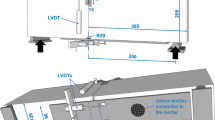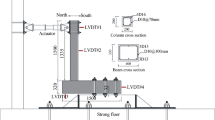Abstract
The current study aims to assess the shear behaviour of reinforced mortar beams including Polyvinyl Alcohol Fibre (PVA) ranges from 0 to 2.25%, fly ash (55%) and silica fume (15%). Fourteen beams were experimentally tested under two concentrated loads. In addition, a finite element model was developed to predict the crack pattern, load–deflection, energy absorption, and shear strength results of the test beams. The studied variables were different percentages of PVA fibres, shear span to depth ratio (a/d), and transverse reinforcement (stirrups) ratio. The fly ash and silica fume were kept constant in all the studied mixes to achieve a compressive strength above 55 MPa at the time of testing (90 days) and to improve PVA-mortar properties. It was found that the inclusion of PVA improves the shear behavior of the tested beams in terms of crack pattern and ductility. It was observed also that reducing a/d led to enhancing the shear capacity without changing the mode of failure. In addition, PVA played the same role as the stirrups and their effect on the ultimate shear capacity was increased with reducing the volume of stirrups. Moreover, the PVA fibres were more effective in lower shear span to depth ratio (a/d = 1.5) giving an enhancement of shear resistance of 221%. The non-linear finite element model showed excellent agreement with the experimental results and the ratio of the predicted to experimental ultimate strength ranged between 0.91 and 1.09. The authors recommend a combination of fly ash, silica fume and at least 1.5% PVA in the presence of minimum stirrups reinforcement (5\(\Phi\)6/m) or adding 2.25% PVA without stirrups to achieve adequate shear behaviour and to improve the ductility of PVA-mortar beams.





















Similar content being viewed by others
References
Pan Z, Wu C, Jianzhong L, Wang W, Jiwei L (2015) Study on mechanical properties of cost-effective polyvinyl alcohol engineered cementitious composites (ECC-PVA). Construct Build Mater 78:397–404
Li VC, Wu C, Wang SX, Ogawa A, Saito T (2002) Interface tailoring for strain-hardening polyvinyl alcohol-engineered cementitious composite (PVA-ECC). ACI Mater J 99(5):463–472
Li VC (1998) Engineered cementitious composites—tailored composites through micromechanical modeling. In: Banthia N, Bentur A, Mufti AA (eds) Fiber reinforced concrete: present and the future. Canadian Society for Civil Engineering, Montreal, pp 64–97
Iqbal Khan M, Fares G, Mourad S (2017) Optimized fresh and hardened properties of strain hardening cementitious composites: effect of mineral admixtures, cementitious composition, size, and type of aggregates. J Mater Civ Eng 29(10):04017178-1–16
Li, Victor C (1993) From Micromechanics to structural engineering - the design of cementitous composites for civil engineering applications. JSCE J Struct Mech Earthq Eng JSCE J 10(2): 37–48, http://hdl.handle.net/2027.42/84735.
Zhang R, Matsumoto K, Niwa J, Hirata T, Ishizeki Y (2013) Experimental study on shear behaviour of PP-ECC BEAMS with different stirrups Ratios. In: Proceedings of the Thirteenth East Asia-Pacific Conference on structural engineering and construction (EASEC-13), September 11–13, 2013, Sapporo, Japan, B-5–5., B-5–5, http://hdl.handle.net/2115/54260
Zhu Y, Zhang Z, Yang Y, Yao Y (2014) Measurement and correlation of ductility and compressive strength for engineered cementitious composites (ECC) produced by binary and ternary systems of binder materials: FLY ash, slag, silica fume and cement. Constr Build Mater 68:192–198
Kanda T, Li VC (1998) Interface property and apparent strength of high-strength hydrophilic fibre in cement matrix. J Mater Civ Eng 10(1):5–13
Kanda T, Watanabe S (1998) Application of pseudo strain hardening cementitious composites to shear resistant structural elements”, fracture mechanics of concrete structures. In: Proceedings FRAMCOS-3, AEDIFICATIO Publishers, D-79104 Freiburg, Germany, 1998, pp. 1477–1490.
Alyousif A, Anil O, Sahmaran M, Lachemi M, Yildirim G, Ashour A (2016) Comparison of shear behaviour of engineered cementitious composite and normal concrete beams with different shear span lengths. Mag Concr Res 68(5):217–228. https://doi.org/10.1680/jmacr.14.00336 (Paper 1400336)
Paegle I, Fischer G (2016) Phenomenological interpretation of the shear behavior of reinforced Engineered Cementitious Composite beams. Cement Concr Compos 73:213–225. https://doi.org/10.1016/j.cemconcomp.2016.07.018
Liu H, Zhang Q, Gu C, Su H, Li VC (2017) Self-healing of micro cracks in Engineered Cementitious Composites under sulfate and chloride environment. Constr Build Mater 153(30):948–956. https://doi.org/10.1016/j.conbuildmat.2017.07.126
Ismail MK, Hassan AA (2019) Influence of fibre type on the shear behaviour of engineered cementitious composite beams. Mag Concr Res. https://doi.org/10.1680/jmacr.19.00172
Liu Y, Zhou X, Lv C, Yang Y, Liu T (2018) Use of silica fume and GGBS to improve frost resistance of ECC with high-volume fly ash, Hindawi. Adv Civ Eng. https://doi.org/10.1155/2018/7987589
Wang L, Zhou SH, Shi Y, Tang SW, Chen E (2017) Effect of silica fume and PVA fibre on the abrasion resistance and volume stability of concrete. Compos B 130:28–37
EN 197 EN 197–2004 (2004) Cement; Composition, specifications and conformity criteria”, European standards (2004/1–197EN)
ASTM C 618 (2012) Standard Specification for coal fly ash and raw or calcined natural Pozzolan for use in concrete. ASTM, West Conshohocken, p 3
ASTM C1240 (2015) Standard Specification for Silica Fume Used in Cementitious Mixtures, West Conshohocken, Pennsylvania; 2015
Cao L (2010) Experimental study on mechanical property of PVA-fiber reinforced cementitious composite. [Master’s thesis], Zhengzhou, China: Henan Polytechnic University, 2010
Said M, Mustafa TS, Shanour AS, Khalil MM (2020) Experimental and analytical investigation of high performance concrete beams reinforced with hybrid bars and polyvinyl alcohol fibers. Constr Build Mater 259:1–22. https://doi.org/10.1016/j.conbuildmat.2020.120395
Egyptian Standard Specifications (2002) Concrete Aggregates from natural sources”, ESS No 1109/2002
BS EN 934–2 2009 Edition (2009) Admixtures for concrete, mortar and grout Part 2: Concrete admixtures—definitions, requirements, conformity, marking and labelling
Egyptian Standard Specifications, “Steel Reinforcement Bars”, No. 262/1999
ECP (Egyptian Code of Practice) (2007) ECP 203-2007: design and construction for reinforced concrete structures. Ministry of Building Construction, Research Center for Housing, Building and Physical Planning, Cairo, Egypt
Zhou J, Qian S, Ye G, Copuroglu O, Breugel KV, Li VC (2012) Improved fibre distribution and mechanical properties of engineered cementitious composites by adjusting the sequence. Cement Concr Compos 34(3):342–348
Meng D, Lee CK, Zhang YX (2017) Flexural and shear behaviours of plain and reinforced polyvinyl alcohol-engineered cementitious composite beams. Eng Struct 151:261–272. https://doi.org/10.1016/j.engstruct.2017.08.036
Qudah S, Maalej M (2014) Applications of engineered cementitious composites (ECC) in interior beam-column connections for enhance seismic resistance. Eng Struct 69:235–245. https://doi.org/10.1016/j.engstruct.2014.03.026
Hasib M, Hossain K (2016) Shear resistance of composite beams without shear reinforcement. In: Resilient Infrastructure Conference, June 1–4, 2016, pp. STR-928–1–8
Shimizu K, Kanakubo T, Kanda T, Nagai S (204) Shear behavior of steel reinforced ECC-PVA beams. In: 13th World Conference on Earthquake Engineering, Vancouver, B.C., Canada, August 1–6, 2004, Paper No. 704
Said M, Abd-Elazim A, Ali M, Elghazaly H, Shaaban IG (2020) Effect of elevated temperature on axially and eccentrically loaded columns containing polyvinyl alcohol (PVA) fibres. Eng Struct. https://doi.org/10.1016/j.engstruct.2019.110065
Hossain KMA, Hasib S, Manzur T (2020) Shear behavior of novel hybrid composite beams made of self-consolidating concrete and engineered cementitious composites. Eng Struct 202:109856
ANSYS–Release Version 14.5 (2012) A finite element computer software and user manual for nonlinear structural analysis. ANSYS Inc., CanonsburgA
Shanour AS, Said M, Arafa AA, Adam A (2018) Flexural performance of concrete beams containing engineered cementitious composites. Constr Build Mater 180:23–34
Soroushian P, Lee C-D (1989) Constitutive modeling of steel fiber reinforced concrete under direct tension and compression. Fiber reinforced cements and concrete: recent developments. In: Proceedings of an International Conference held at the University of Wales, College of Cardiff, School of Engineering, UK, Sep. 18-20, 1989, pp 363–377
CSA Standard A23.3–04 (2004) Canadian standard association (CSA). Design of concrete structures, CSA standard A23.3–04, Rexdale, Ontario. 2004.
Beshara FB, Mustafa TS, Mahmoud AA, Khalil M (2020) Constitutive models for nonlinear analysis of SFRC Corbels. J Build Eng 28:1–15. https://doi.org/10.1016/j.jobe.2019.101092
Yang E, Li VC (2010) Strain-hardening fiber cement optimization and component tailoring by means of a micromechanical model. Constr Build Mater 24:130–139
Funding
The authors declare that they have no known competing financial interests or personal relationships that could have appeared to influence the work reported in this paper. The authors state that they did not get any funding for this research and it is self-funded.
Author information
Authors and Affiliations
Corresponding author
Ethics declarations
Conflict of interest
The authors declare that they have no conflict of interest.
Human and animal rights
This article does not contain any studies with human participants or animals performed by any of the authors.
Rights and permissions
About this article
Cite this article
Said, M., Montaser, W., Elgammal, A.S. et al. Shear Strength of Reinforced Mortar Beams Containing Polyvinyl Alcohol Fibre (PVA). Int J Civ Eng 19, 1155–1178 (2021). https://doi.org/10.1007/s40999-021-00628-6
Received:
Revised:
Accepted:
Published:
Issue Date:
DOI: https://doi.org/10.1007/s40999-021-00628-6




